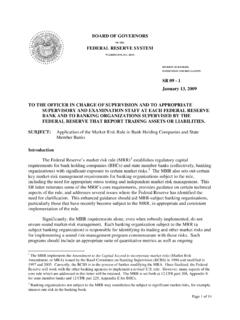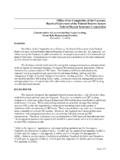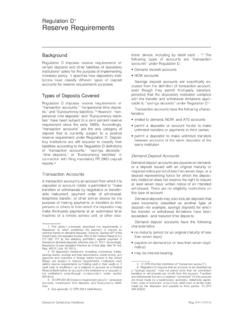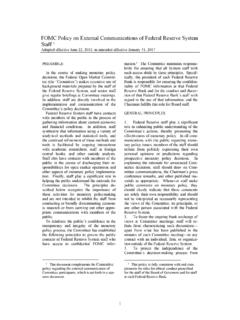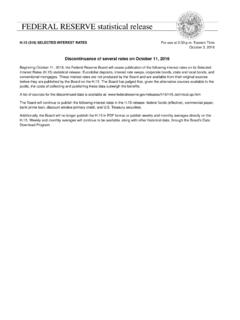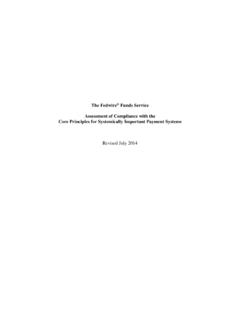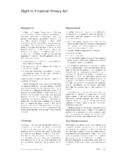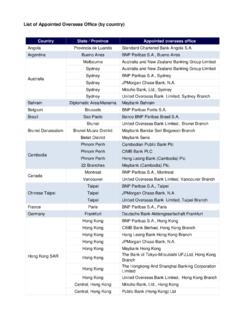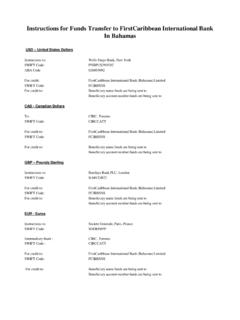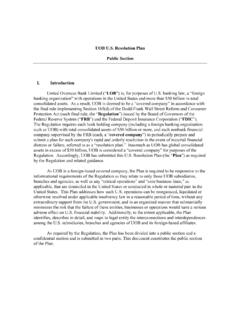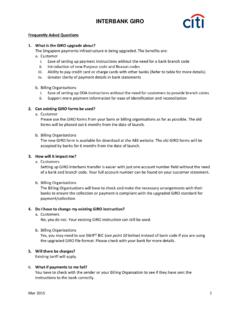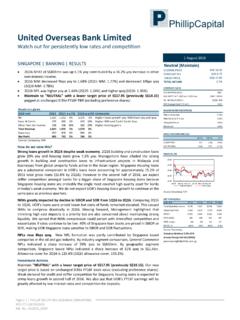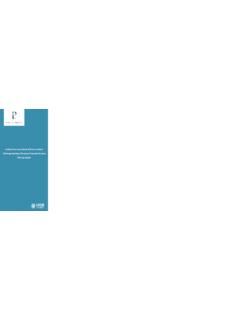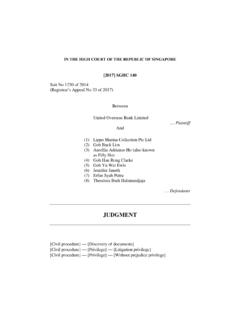Transcription of UOB U.S. Resolution Plan Public Section I. Introduction ...
1 UOB Resolution plan Public Section I. Introduction united overseas bank limited ( UOB ) is, for purposes of banking law, a foreign banking organization with operations in the united States and more than US$50 billion in total consolidated assets. As a result, UOB is deemed to be a covered company in accordance with the final rule implementing Section 165(d) of the Dodd-Frank Wall Street Reform and Consumer Protection Act (such final rule, the Regulation ) issued by the Board of Governors of the Federal Reserve System ( FRB ) and the Federal Deposit Insurance Corporation ( FDIC ). The Regulation requires each bank holding company (including a foreign banking organization such as UOB) with total consolidated assets of US$50 billion or more, and each nonbank financial company supervised by the FRB (each, a covered company ) to periodically prepare and submit a plan for such company's rapid and orderly Resolution in the event of material financial distress or failure, referred to as a Resolution plan .
2 Inasmuch as UOB has global consolidated assets in excess of US$50 billion, UOB is considered a covered company for purposes of the Regulation. Accordingly, UOB has submitted this Resolution plan (the plan ) as required by the Regulation and related guidance. As UOB is a foreign-based covered company, the plan is required to be responsive to the informational requirements of the Regulation as they relate to only those UOB subsidiaries, branches and agencies, as well as any critical operations and core business lines, as applicable, that are domiciled in the united States or conducted in whole or material part in the united States. This plan addresses how such operations can be reorganized, liquidated or otherwise resolved under applicable insolvency law in a reasonable period of time, without any extraordinary support from the government, and in an organized manner that substantially minimizes the risk that the failure of these entities, businesses or operations would have a serious adverse effect on financial stability.
3 Additionally, to the extent applicable, the plan identifies, describes in detail, and maps to legal entity the interconnections and interdependences among the subsidiaries, branches and agencies of UOB and its foreign-based affiliates. As required by the Regulation, the plan has been divided into a Public Section and a confidential Section and is submitted in two parts. This document constitutes the Public Section of the plan . 2 Overview UOB is incorporated and headquartered in the Republic of Singapore, and has a global network of more than 500 offices in 19 countries and territories in Asia Pacific, Western Europe and North America. It is a leading bank in Asia, where it operates through its branches and representative offices as well as through its banking subsidiaries in Singapore, Malaysia, Thailand, Indonesia, China, and the Philippines.
4 UOB provides a wide range of financial services including: Personal Financial Services Private Banking Business Banking Commercial and Corporate Banking Transaction Banking Investment Banking Corporate Finance Capital Market Activities Treasury Services Brokerage and Clearing Services Asset Management Venture Capital Management Insurance As of 31 December 2014, UOB s total global assets, inclusive of its non-banking subsidiaries, was US$ billion as reported on its Form FR Y-7. Operations UOB maintains a very small presence in the united States, consisting of merely two agency offices and a handful of non-banking subsidiaries, including two broker-dealers, a fund manager, a premises holding company, and several non-operating companies (collectively, the Entities ).
5 As of 31 December 2014, UOB New York and Los Angeles agency offices held US$ billion and US$ billion in assets (which consisted primarily of interests in commercial loans) respectively. The remaining subsidiaries1 collectively held US$129 million in assets. UOB employs only 59 people within the united States across its two agency offices and various non-banking subsidiaries. 1 One of the subsidiaries, UOB Funding LLC, was a special purpose vehicle that formerly issued commercial paper in the in order to fund the operations of the UOB New York agency office. UOB Funding LLC was closed on 22 December 2014. 3 II. Material Entities A "material entity" is defined in the Regulation as "a subsidiary or foreign office of the covered company that is significant to the activities of a critical operation or core business line.
6 " UOB has no critical operations as that term is defined in the As explained in the next paragraph, UOB s Entities do not comprise a core business line of UOB, and UOB s Entities do not engage in any activities or provide any services that are significant to any of those core business lines conducted outside the united States. Based on these criteria, none of UOB s entities are material entities for purposes of the plan . III. Core Business Lines "Core business lines" are defined in the Regulation as "those business lines of the covered company, including associated operations, services, functions and support, that, in the view of the covered company, upon failure would result in a material loss of revenue, profit, or franchise value." Although UOB conducts a limited amount of commercial lending, broker-dealer, investment management and other activities through its Entities, the potential cessation of these activities, or the failure of one or more of the Entities, would not materially impact UOB s business operations as a whole, and would not result in a material loss of revenue, profit, or franchise value to UOB.
7 As a result, UOB does not believe that any of its core business lines are conducted in whole or in material part in the united States. IV. Summary Financial Information Regarding Assets, Liabilities, Capital, and Major Funding Sources The summary financial information in this Section was prepared in accordance with Singapore Financial Reporting Standards and the provisions of Chapter 50 of the Singapore Companies Act, and appears as it is set forth in UOB s 2014 Annual Report. Unless otherwise indicated, all amounts are denominated in Singapore Dollars. The balance sheet contains columns showing information for both united overseas bank limited itself (the column labeled bank ) and together with its global subsidiaries (the Group ), and reflects UOB s financial condition as of 31 December 2014.
8 Unless otherwise indicated, the following information pertains to UOB s global operations as a whole. 2 The Regulation defines critical operations as those operations of the covered company, including associated services, functions and support, the failure or discontinuance of which, in the view of the covered company or as jointly directed by the FRB and the FDIC, would pose a threat to the financial stability of the united States. UOB has not been notified by the FRB or the FDIC that it engages in critical operations. 4 5 Major Funding Sources and Liquidity UOB s overall global funding position remained strong throughout 2014, with loans-to-deposits ratio at as of 31 December 2014. UOB maintains sufficient liquidity to fund its day-to-day operations, to meet deposit withdrawals and loan disbursements, to participate in new investments and to repay borrowings.
9 Hence, liquidity is managed in a manner to address known as well as unanticipated cash funding needs. Liquidity risk is managed in accordance with a framework of policies, controls and limits approved by the Asset and Liability Committee ( ALCO ). These policies, controls and limits enable UOB to monitor and manage liquidity risk to ensure that sufficient sources of funds are available over a range of market conditions. These include minimizing excessive funding concentrations by diversifying the sources and terms of funding as well as maintaining a portfolio of high quality and marketable debt securities. UOB takes a conservative stance in its liquidity management by continuing to gather core deposits, ensuring that liquidity limits are strictly adhered to and that there are adequate liquid assets to meet cash shortfall.
10 The distribution of deposits is managed actively to ensure a balance between cost effectiveness, continued accessibility to funds and diversification of funding sources. Important factors in ensuring liquidity are competitive pricing, proactive management of UOB s core deposits and the maintenance of customer confidence. Liquidity risk is aligned with the regulatory liquidity risk management framework and is measured and managed on a projected cash flow basis. UOB is monitored under business as usual and stress scenarios. Cash flow mismatch limits are established to limit UOB s liquidity exposure. UOB also employs liquidity early warning indicators and trigger points to signal possible contingency situations. With regard to the regulatory requirements on Liquidity Coverage Ratio (LCR) which are effective from 1 January 2015, UOB ratios were above 100% for both the All Currencies LCR and the Singapore Dollar LCR as of 31 December 2014.
